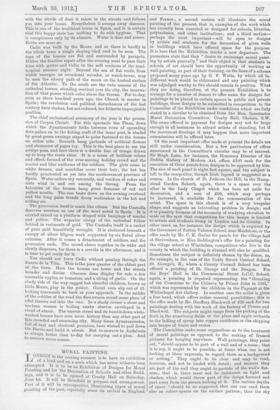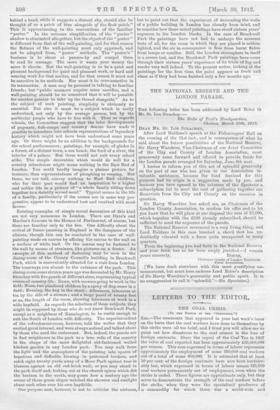MURAL PAINTING.
ONDON in the corning summer is to have an exhibition of a kind and on a scale which has never hitherto been attempted. It is to be an Exhibition of Designs for Mural Painting and for the Decoration of Schools and other Build- ings, and it is to be opened at Crosby Hall on Saturday, June 1st. It will be threefold in purpose and arrangement. Part of it will be retrospective, illustrating types of mm.al painting of the past, especially since its revival in England
and France ; a second section will illustrate the mural painting of the present, that is, examples of the work which has recently been executed or designed for schools, libraries, polytechnics, and other institutions ; and a third section— perhaps the most important—will be open to designs by artists and students for the decoration of given walls in buildings which have offered space for the purpose. It is here that the Exhibition marks a new departure. The promoters state that they "desire to encourage mural paint- ing by artists generally," and their object is that students in schools of art should have the opportunity of working at wall-painting, as part of their training, on the lines of a scheme proposed many years ago by G. F. Watts, by which all in- different work would be obliterated and any painting which was adjudged worthy to live should remain in position. What they are doing, therefore, at the present Exhibition is to arrange for a number of donors to offer sums for designs for paintings to be placed in certain spaces in public and private buildings, these designs to be submitted in competition to the Committee of the Exhibition under conditions which are fully stated in a circular to be obtained from the Hon. Secretaries Mural Decoration Committee, Crosby Hall, Chelsea, S.W. The sums offered in payment for designs may not be large enough in all instances to attract artists of standing, but if the movement develops it may happen that more important commissions will be offered later.
Of the most important offer made at present the details are still under consideration. But a few particulars of offers announced in the Committee's circular may be of interest. Sir Hugh Lane, for instance, the Honorary Director of the Dublin Gallery of Modern Art, offers £100 each for the execution of three panels from designs to be approved by him. The size of each panel is eight feet square, and the subject is left to the competitor, though Irish legend is suggested as a source. In the church of St. Jude-on-the-Hill, in the Hamp- stead Garden Suburb, again, there is a space over the altar in the Lady Chapel which has been set aside for decoration, and a sum of £50, which may perhaps be increased, is available for the remuneration of the artist. The space in this church is of a very irregular shape, and suggests an interesting problem in design; and it is possibly because of the necessity of studying elevation to scale on the spot that competition for this design is limited to artists and students living in London and its vicinity. In other cases, as, for instance, the design which is required by the Governors of Sutton Valence School, near Maidstone, or the offer made by Mr. C. K. Butler for panels for the village hall at Shrivenham, or Miss Beddington's offer for a painting for the village school at Winehelsea, competitors who live in the county in which the building is situated will also be qualified. Sometimes the subject is definitely chosen by the donor, as, for example, in the case of the Cable Street Central School, St. George's, E., where a County Council School has been offered a painting of St. George and the Dragon. For the Boys' Hall in the Commercial Street L.O.O. School, again, a painting is required representing the "Granting of the Commune to the Citizens by Prince John in 1191," which was represented by the children in the Pageant at the Whitechapel Art Gallery. In another case the artist is given a free hand, which offers rather unusual possibilities: this is the offer made by Mr. Geoffrey Blackwell of £25 each for two paintings dealing with the work of the factory of Crosse and Blackwell. The subjects might range from the picking of the fruit in the strawberry fields or the plum and apple orchards to the ladling of syrup into copper cauldrons or the shipping into barges of boxes and crates.
The Committee make some suggestions as to the treatment of mural paintings as opposed to the making of framed pictures for hanging anywhere. Wall-paintings, they point out, "should appear to be part of a wall and of a room ; that is to say, it ought to be possible, at times when one is not looking at them expressly, to regard them as a background or setting." They ought to be clear and easy to read, however, and not be loaded with detail; and because they are part of the wall they ought to partake of the well's flat- ness ; that is, there must not be insistence on light and shadow, which would throw part of the design forward and part away from the person looking at it. The various depths of space "should be so suggested that one can read them also as colour-spaces on the surface pattern ; thus the sky
behind a bead, while it suggests a distant sky, should also be thought of as a patch of blue alongside of the flesh patch." This is approximating to the conventions of the familiar "poster." In the extreme simplification of the " poster " shadow is eliminated altogether, but the object of the " poster " is different from that of the wall-painting, and for that reason the flatness of the wall-painting must only approach, and not be adopted from, " poster " methods. The " poster's " business is to shout at passers-by and compel them to read its message. The more it wants your money the more it shouts. But the wall-painting is to be a quiet and pleasant background for quiet and pleasant work, or hard and wearing work for that matter, and for that reason it must not be assertive in its methods. Nor must it be over-assertive in its mannerism. A man may be personal in talking to familiar friends; but "public manners require some sacrifice, and a wall-painting should be so conceived that it will be possible for another painter to take up the thread alongside." As to the subject of such painting, simplicity is obviously an essential. But also it must be a subject which is easily understood, not only by the average person, but by the particular people who have to live with it. Thus as regards Rchools, the Committee suggest that the later developments
of pageants, folk-songs, and country dances have made it possible to introduce into schools representations of legendary history which might not have been understood some years ago. Or there might be an addition to the backgrounds for the school performances ; paintings, for example, of glades in a forest, of a distant town, a sea beach, the ford of a river, the interior of a palace. But these would not suit every school alike. The simple decoration which would do well for a country schoolroom might mean nothing in the East End of
London. You could hardly imagine a plainer picture, for instance, than representations of ploughing or reaping. But
these, we are told, convey nothing to East End children, who for their part would find an inspiration to a higher and nobler life in a picture of "a whole family sitting down together to a daintily served meal." Typical scenes in the life of a family, particularly if the scenes are in some way pro- gressive, appear to be understood best and received with most favour.
Existing examples of simple mural decoration of this kind are not very numerous in London. There are Dyce's and Islaclise's frescoes in the Houses *of Parliament, of course, but these are familiar only to the few. One difficulty about the revival of fresco painting in England is the dampness of the climate, though this can be combated in the case of wall- painting made on canvas by affixing the canvas to the wall on a surface of white lead. Or the canvas may be fastened to the wall by means of strainers, like pictures on a frame. An example of this method of fastening may be seen in the dining-room of the County Council's building in Brockwell Park, which is conveniently situated for a visit from London. The tramways run almost to the entrance of the park. This dining-room some sixteen years ago was decorated by Mr. Henry Strachey with five panels of different sizes, representing typical scenes of country life : Dawn, with mowers going to work in the field; Noon, two pinafored children by a spray of dog-roses in a field ; Evening, the hay in the stack ; Afternoon, labourers at tea by the side of a stream ; and a large panel of twenty feet or so, the length of the room, showing labourers at work in a wide hayfield. As regards the selection of these subjects, they might be supposed by those who do not know Brockwell Park, except as a neighbour of Kennington, to be rustic enough to suit the South of London with difficulty. The superintendent of the refreshment-room, however, told the writer that they excited great interest, and were always noticed and talked about by those who used the restaurant. But, indeed, the panels are in fact neighbours in the park to a true relic of the country in the shape of the most delightful old-fashioned walled kitchen garden in any London park. You may walk from the light and the atmosphere of the painting into spaces of hepaticas and daffodils blowing in patterned borders, and catch sight twenty yards away of a Moor Park apricot tree in blossom against an old red-brick wall; or you may stand in the park itself and, looking out at the church spires which dot the horizon to the south, may guess how a century ago the owner of those green slopes watched the showers and sunlight chase each other over his own hayfields.
Our purpose now, however, is not to criticise the pictures, but to point out that the experiment of decorating the walls of a public building in London has already been tried, and to consider bow these mural paintings have stood sixteen years' exposure to the London blacks. In the case of Brockwell Park the paintings have not bad to undergo the severest tests of all, for the room in which they are placed is seldom lighted, and the air in consequence is free from burnt flakes from lamps or candles. Still, the London atmosphere in itself is a severe test, and the Brockwell Park paintings have come through their sixteen years' experience of its trials of fog and smoke very well indeed. To the present writer, looking at the paintings for the first time, the paint appears as fresh and clean as if they had been finished only a few months ago.







































 Previous page
Previous page